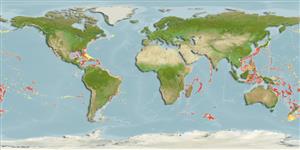分類 / Names
共通名の | 類義語 | Catalog of Fishes(部類, 種) | ITIS | CoL | WoRMS | Cloffa
Environment: milieu / climate zone / depth range / distribution range
生態学
海 底生の漂泳性; 深さの範囲 260 - 775 m (Ref. 57911). Deep-water
Widespread in tropical Atlantic and Indo-West Pacific Oceans.
サイズ / 重さ / 年齢
Maturity: Lm ? range ? - ? cm
Max length : 37.1 cm TL オス/雌雄の選別がない; (Ref. 13608)
簡単な記述
検索表 | 形態学 | 形態計測学
脊つい: 133 - 141. This species is distinguished by the following characters: with pectoral fin; dorsal-fin origin over tip of pectoral fin, predorsal length 14.0-17.1% TL; anus posterior, more than 1 head length behind pectoral fin, preanal length 26.8-28.8% TL; trunk long, trunk length 12.8-16.4% TL; intermaxillary teeth absent; vomer with 4 compound teeth; upper and lower jaws with multiple rows of teeth; head pores: IO 4, SO 3, M 6, POP 0, AD 1, ST 0, F 0; lateral-line pores absent; MVF 11-28-136, total vertebrae 133-141; colour of body light brownish dorsally, paler ventrally; dorsal and anal fins with white margin, posterior one third of anal-fin base and posterior one-seventh of anal fin black (Ref. 106136).
On the continental slope (Ref. 57911).
Life cycle and mating behavior
Maturities | 繁殖 | Spawnings | Egg(s) | Fecundities | 幼生
Uyeno, T., K. Matsuura and E. Fujii (eds.), 1983. Fishes trawled off Suriname and French Guiana. Japan Marine Fishery Resource Research Center, Tokyo, Japan. 519 p. (Ref. 13608)
Human uses
用具
特記事項
XMLをダウンロードして下さい
インターネットの情報源
Estimates based on models
Preferred temperature (Ref.
123201): 6.8 - 15.4, mean 10.1 °C (based on 336 cells).
Phylogenetic diversity index (Ref.
82804): PD
50 = 0.7500 [Uniqueness, from 0.5 = low to 2.0 = high].
Bayesian length-weight: a=0.00102 (0.00046 - 0.00225), b=3.06 (2.88 - 3.24), in cm total length, based on all LWR estimates for this body shape (Ref.
93245).
栄養段階 (Ref.
69278): 3.8 ±0.3 se; based on size and trophs of closest relatives
回復力 (Ref.
120179): 低い, 4.5年~14年の倍増期間の最小個体群 (Assuming tmax>10).
Fishing Vulnerability (Ref.
59153): Low to moderate vulnerability (27 of 100).
